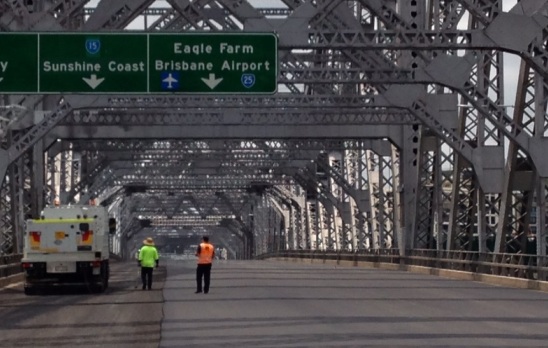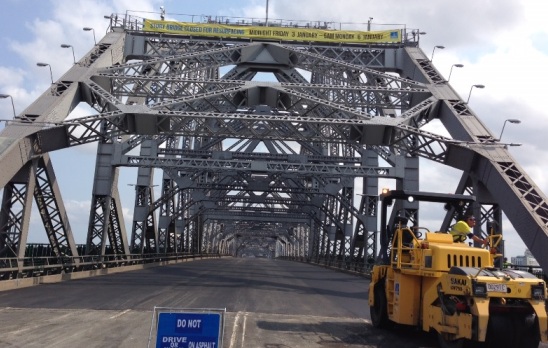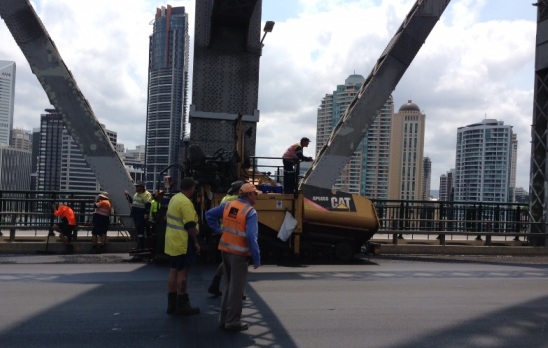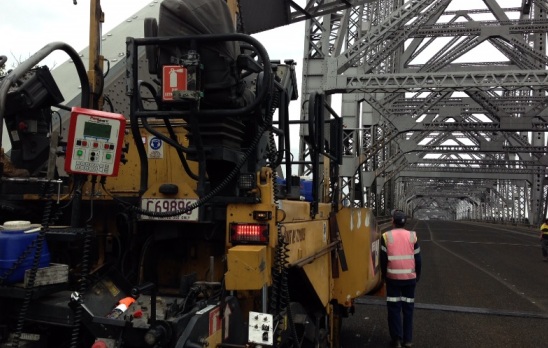About Us

Story Bridge Resurfacing
When Brisbane’s landmark Story Bridge closed for road maintenance for the time in 20 years in January 2014, it was vital the resurfacing work proceeded with the precision of the proverbial Swiss watch.
“Being a central component of the city’s arterial routes and a heritage-listed bridge, this certainly was a high profile job. But actually the entire resurfacing project went off without a hitch,” says Synergy Positioning Systems’ operations manager Darren McDonnell.
“We did our prep work first though. In conjunction with the main client, Brisbane City Council, we undertook a night shift profilograph survey a week out from when the actual work commenced.
“This allowed us to check the geometric shape of the existing bridge deck prior to the old surface being milled off. While in this particular instance the resurface layer of asphalt was prescribed to be a nominal thickness, the profilograph still allowed us to check ride quality as well.”
Story Bridge carries an average of 97,000 cars a day and lies at the heart of Brisbane’s urban commuter road network. The 777m long steel cantilevered bridge was opened in 1940 and connects Brisbane’s southern and northern suburbs, spanning the Brisbane River.
Completed over a single weekend, the resurfacing work included all six transit lanes on the bridge, with the work crew utilising two paving machines, both running Synergy’s patented PaveSmart system.
“Essentially the profiler went in on Saturday night and paving commenced Sunday. We had two Synergy guys onsite managing the PaveSmart systems on each machine.”
The system can be fitted to any asphalt paver or milling machine to control levels and provide for accurate variable depth paving to within extremely precise tolerances.
“The bridge surface came up very nice indeed,” continues Darren.
Gallery
“The PaveSmart system is very good at dealing with varying levels of compaction. A 28mm layer of asphalt was laid, although being a steel cantilevered bridge it features expansion joints every 13 metres. So we were controlling the paving depth across these sections as well; down to 5mm on top of steel.”
Under normal operating environments, the system involves an initial survey to determine the precise paving depth for each consecutive run the asphalt paver needs to make.
The resultant survey grid is uploaded to the PaveSmart grade control system. From there the system automatically adjusts the hydraulic controls on the paver to achieve the desired depths, even accounting for the effects of differential compaction.
“The PaveSmart system really is an essential tool for getting the best results, especially in a time sensitive environment such as we worked in on the Story Bridge project. We certainly helped ensure the Brisbane traffic was flowing again by Monday morning,” concludes Darren.
“If a client requires expertise in achieving fantastic ride quality, Synergy has the manpower and the technology to provide the perfect solution.”
For more information on our range of asphalt and paving services including Pavesmart, click here.
Back to all case studiesRelated Case Studies
-

Downer engages Synergys’ PaveSmart Grade Control
Downer recently engaged Synergy Positioning Systems’ survey consultancy service and PaveSmart grade control system to ensure time and cost savings on resurfacing a lengthy section of Christchurch arterial road....
Read More -

Economics of using PaveSmart
While Synergy Positioning Systems’ patented PaveSmart asphalt paving technology can’t help companies predict the future, it’s certainly capable of eliminating risk....
Read More







